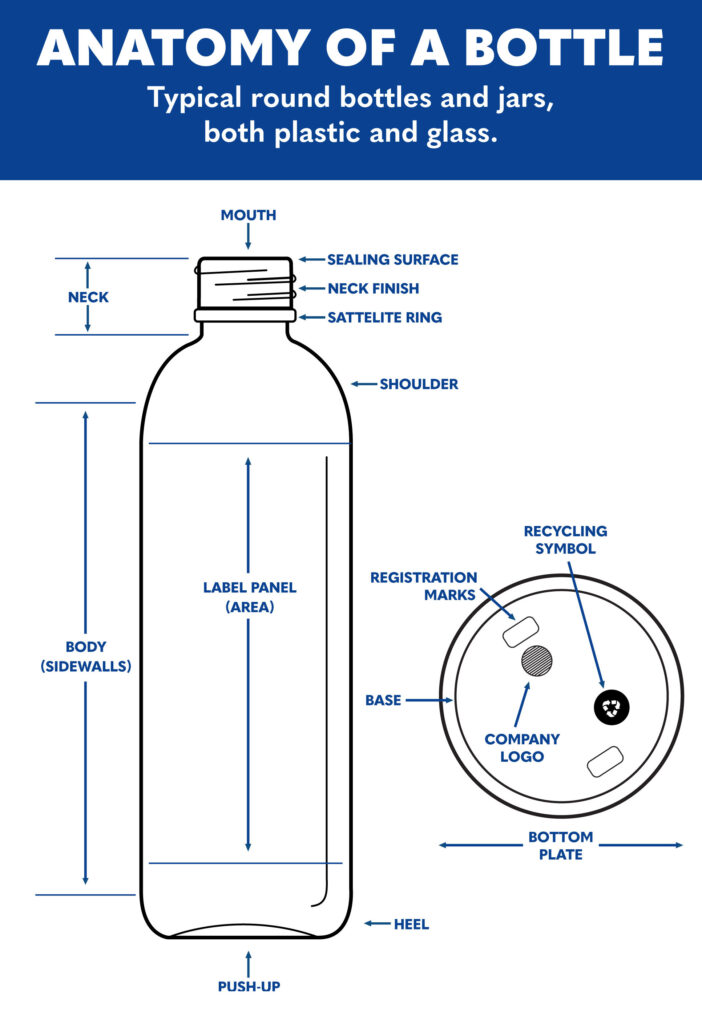This easy-to-understand bottle anatomy guide explores the different components of bottles, specifically packers for supplements, dropper squeeze bottles for controlled dispensing, and a range of designs for food and beverage.
From bases to neck closures, we’ll explain the key components and terminology, starting with a quick overview of the most essential factor: Bottle Materials.
When you’re choosing the right packaging solution, the material is pivotal for the product’s functionality and sustainability. For a deeper dive into PET vs. HDPE, please see our guide on choosing between these two highly popular options.
Related Read: HDPE vs. PET Plastics: How to Choose the Perfect Option
Below, we’ve included a quick overview of the most common materials used:




Each material has unique features that make it suitable for different packaging needs. Your choice of material can vary depending on what you’re packaging.
If you would like more support in determining the perfect material for your next project, reach out to Comar’s industry experts for support.



Each component of a bottle serves a specific purpose. Understanding these terms can help you make the right choice when selecting a packaging solution. Here is a breakdown of the key parts of a bottle:
When creating the ideal packaging solution, understanding key bottle measurements and terms is crucial for choosing the right option. Familiarity with these common measurements ensures you select the right option for your needs. Here are some of the most common measurements and terms you should know when choosing the right packaging solution.
As previously discussed, the neck finish, or thread size, is the entirety of the protrusion from the container to which the closure (lid) is fastened. For clarification, wider-mouthed containers use “thread size” instead of “neck finish,” so you may see those terms used interchangeably.
Neck finishes are identified by two numbers separated by a hyphen, for example 38-400 as shown in the graphics. The first number (38 in this example) is always in millimeters (mm) and refers to the T dimension in Figure 1, it is the diameter of the outside threads.


As seen in the figure above, a 400 takes 1 full turn, 410 takes 1.5 turns, and 415 takes 2 full turns to close.
In conclusion, a 38-400 is a neck finish that is approximately 38mm wide (diameter) and takes 1 full turn to close.
Please Note: The neck finishes of the container and closure must match exactly to ensure an optimal fit and proper torque (twisting pressure) requirements for your bottle assembly.
For historical and practical reasons, plastic bottle measurements are sometimes expressed in cubic centimeters (cc) or milliliters (mL). While they might seem different, cc and mL are equivalent, representingthe same volume.
One cubic centimeter is equal to one milliliter.
The measurement cc is more commonly used in medical and scientific contexts, while mL is often used in consumer products.
The choice between cc and mL often depends on industry standards, regional preferences, and the product’s intended application. However, both measurements represent the volume of the container and can be used interchangeably.
Understanding the essential parts of a bottle is crucial for making informed decisions, and the choices made should reflect your product’s needs, industry standards, and any regulatory concerns.
Comar invites you to explore the possibilities of sustainable and industry-specific bottle solutions further. We have over 75 years of experience providing high-impact packaging solutions. Our knowledge spans various industries, offering insights into sustainable plastic packaging best practices and trends.
In addition to our experience and comprehensive catalog options, we offer custom-made packaging solutions to fit your business’s branding and aesthetic requirements. Partner with us and get expert assistance in choosing the perfect bottle solutions today.